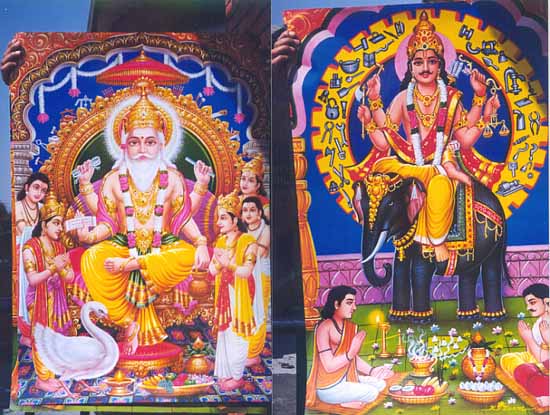
Today is no work but Bishwakarma puja in our shop. This means a special Kali puja along with a lot of additional prayer and ceremony. Chickens and goats will be sacrificed and then, of course, cooked and eaten.
Every khukuri will be blessed, every piece of equipment will be blessed, even our four forges will be blessed. To tell you the truth there will be blood all over the shop but this is a most important ritual to the kamis and in their tradition it is simply something that must be done.
We will supply the animals to be sacrificed and will give bonuses to the kamis and their families who will be in attendance for this special annual religious ceremony.
KAMI SHERPA
Bishwakarma Puja

This is Sri Bishwakarma, Lord of the kamis.
As best as I could get it from the kamis when the world was young there
was no metal or tools. Bishwakarma discovered metal and how to make tools
from it. Because this proved to be such a great blessing for the populace
of the world Bishwakarma was made a Hindu god and here he is -- when he
was a kid and when he became old and wise. Notice the many tools and metal
objects in this artistic rendition.
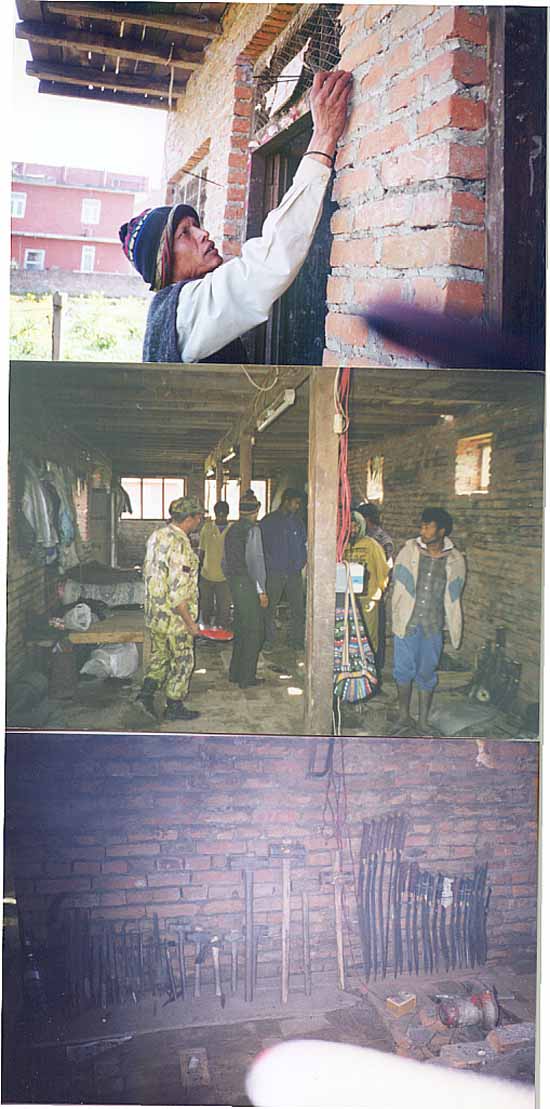
Bishwakarma puja is held at BirGorkha about every six or eight weeks and it is a very religious day for them. There is no work to be done and the day is devoted to morning of puja and afternoon of social activities. Annually, a special Bishwakarma puja is held during which the kamis and any others participating nick themselves on the finger or thumb and incorporate their own blood into the ceremonies. The puja pix I'll be posting was not the annual affair.
top -- mama places incense at the doorways of the shop as an invitation to Sri Bishwakarma to enter.
center -- In typical sgt. style, Sgt. Karka barks, "Men, get this place clean and tidy. Sri Bishwakarma won't enter a dirty, filthy shop!" In his hand Sgt. Karka holds a dish of abir which he will judiciously place throughout the shop. Remember the greeting of the kamis? They did the same for me but I am in no way on the level of Sri Bishwakarma.
bottom -- tools and khukuris in progress are neatly placed against the wall.

top -- mama prepares the altar with offerings of fresh fruit, flowers,
abir and incense.
center -- finished khukuris are placed on an altar, not allowed to
touch the wall or the wood of the altar. A sprinkling of abir is placed
in front of them.
bottom -- Yangdu listens intently as Sgt. Karka explains the significance of Bishwakarma puja to her and tells her how important, meaningful, and truly religious it is to the men of BirGorkha. Because she is a female Yangdu cannot participate in the ceremonies. There may be exceptions to this female exclusion but if there is I don't know about them.
The females did not stay in the shop during the ceremonies. They are
Nepali and understand this is a male dominated society and that this ceremony
is for the men of the shop, not the women. The only women here are Yangdu
and her sister, Dicksung. They most likely would have been chased away
had they not been Pala's daughters. Because he is the sauji, Pala and his
family, including me, get special consideration.
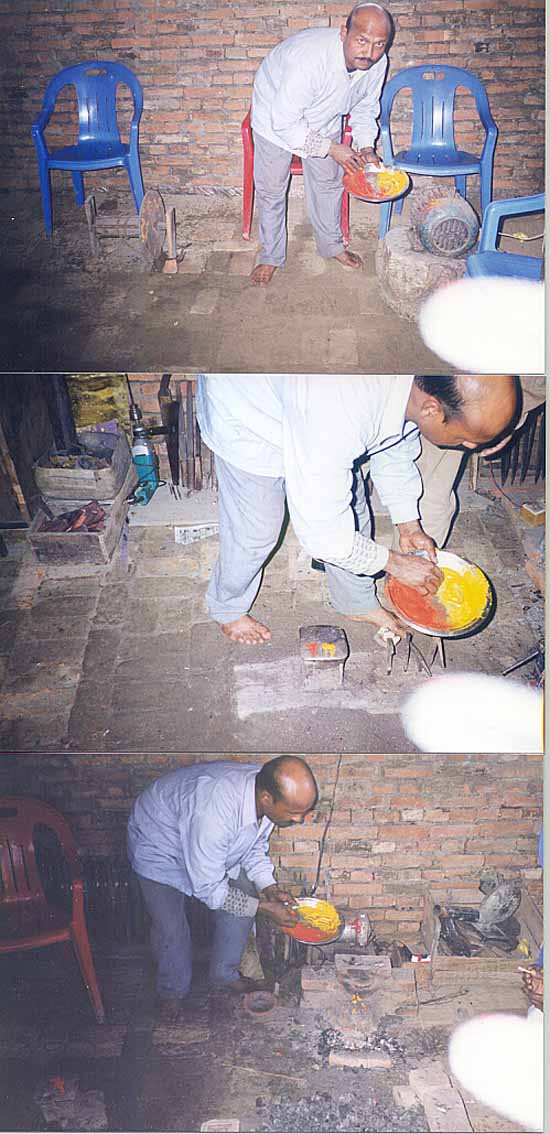
If you think this is not a serious occasion just take a look at the expression on Sgt. Karka's face.
After the shop got cleaned and tidied up, Sgt. Karka changed to civvies and removed his boots. The cow is sacred to the Hindu and wearing a pair of leather boots or shoes is unacceptable during the blessing of the equipment.
EVERYTHING gets blessed, anvils, grinders, hammers, tongs, everything. The tools and equipment must be properly blessed or Sri Bishwakarma will just pass on by and all is lost.
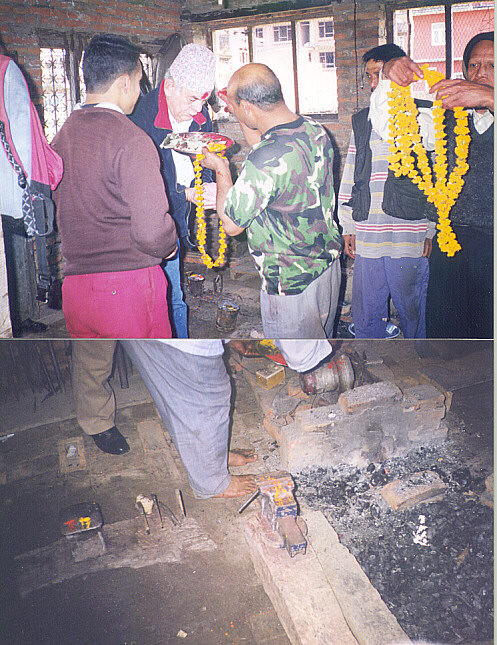
After the shop is in order then the men must be blessed and spiritually cleansed. I am the first in line to be blessed by Sgt. Karka who is our expert and high priest regarding Bishwakarma Puja. This is top pix. After me everybody in the shop received blessing, cleansing and tika as I did. Then we are ready for the sacrificial offering to Sri Bishwakarma.
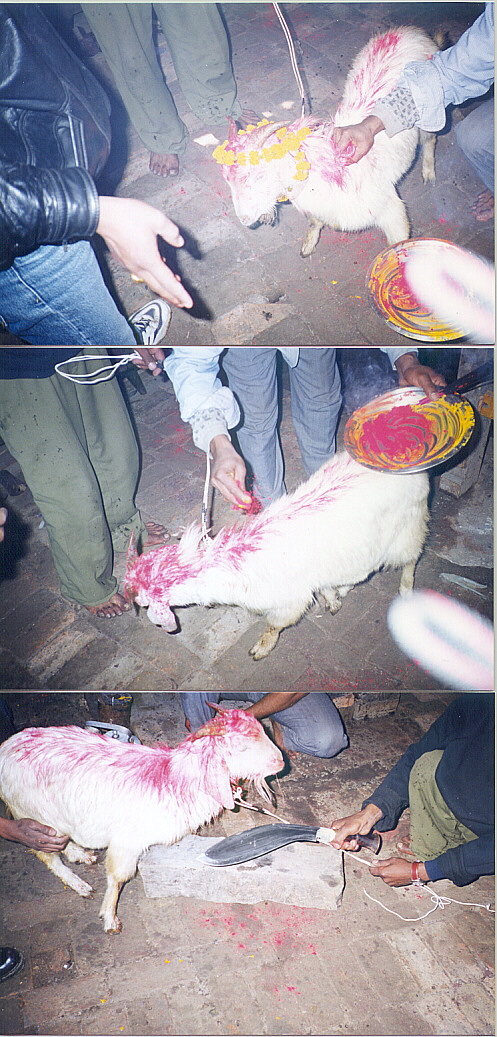
After the shop, equipment and men have been properly cleansed and blessed it is time to prepare for the sacrifice. We have chosen a goat this time but chickens or water buffalo or anything but a cow just about may be used.
The goat receives the same treatment -- cleansing and blessing. The men involved in the actual sacrifice must be barefoot and wear no leather. We say prayers for him and pray that he might get a better life next time and ask that our prayers and blessings will go with him and help him.
After just recently spending a couple of weeks in a hospital undergoing open heart surgery and seeing the suffering of many not as lucky as I was I think this goat did not have such a bad deal. His death of swift and sure and without pain or very little pain. Much easier than what I saw at St. Mary's. And he did not have to suffer the slings and arrows of old age, of watching and feeling himself falling to pieces as I am doing. And there were more people praying for his soul at the time of his death than anybody I saw at St. Mary's. And, he had it much better than any of the millions of animals that were slaughtered for us here in the US today.
I say these thing to try to alert those not familiar with Bishwakarma puja that this is not a barbaric act, but probably as close to the opposite as one can get if you understand the procedure and philosophy. However, I did not watch the actual beheading of the animal and stood at the door of the shop praying to my own gods to help the goat make the transition. Gelbu took the pictures of the actual sacrifice.
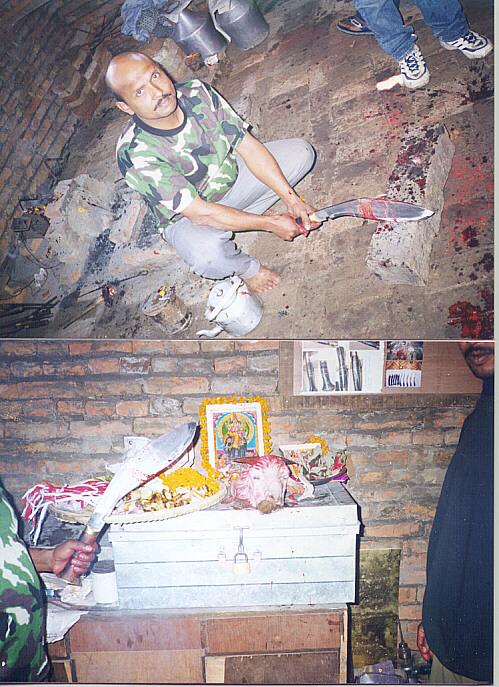
top -- Using a Ganga Ram special made by Bura, Sgt. Karka takes the head of the goat off in one easy blow. This is a serious and holy proposition as you may be able to tell by the expression on Sgt. Karka's face.
Bottom, Prakash and Sgt. Karka, the major players in the sacrifice present the head of the goat to Sri Bishwakarma and do the proper prayer.
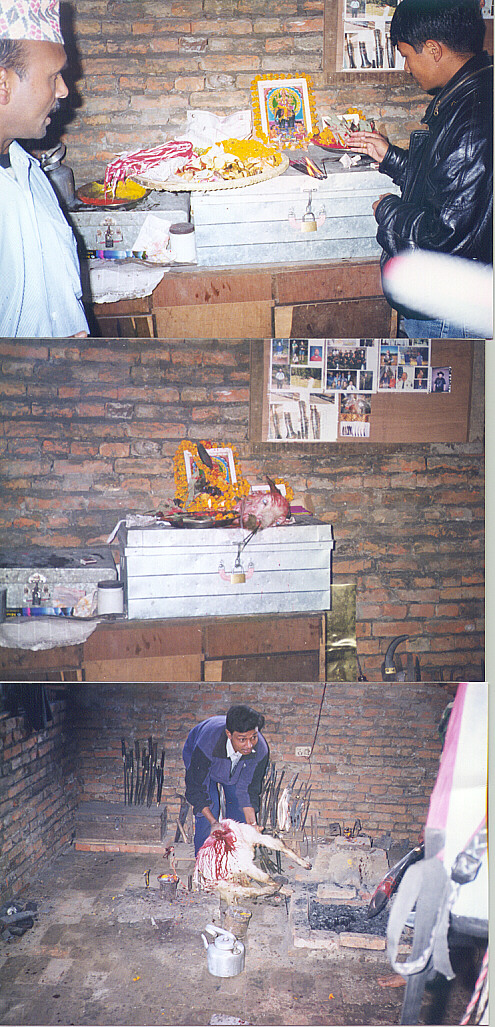
top -- Sgt. Karka instructs Gelbu regarding protocol. Notice the red and white malas on the tray. Each man participating in the Bishwakarma puja will wear one of these around his neck.
center & bottom --After the goat has been sacrificed, head is placed
on the altar and blood is sprinkled on all khukuris and equipment in the
shop along with appropriate prayers. Sanu is handling the blood blessing.
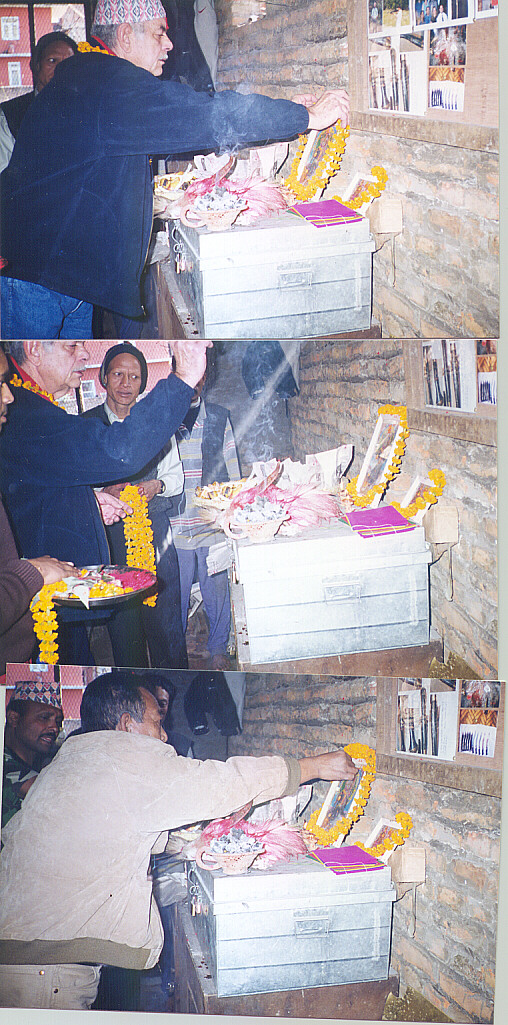
Sgt. Karka is first to do the actual puja following the sacrificing of the goat and instructs me in protocol with which I am not familiar. It is no time for mistakes. I follow the ritual but say my own brand of prayers in my mind and soul.
Pala follows me.
Every kami will follow us and pray to Bishwakarma to bless our shop, the equipment, the men and to insure that the items we produce are the best and carry the appropriate blessing.
Of interest is the fact that the altar for the Bishwakarma puja is the BirGorkha tool box where we keep our power tools and other hand equipment that is worth stealing. It makes me smile when I think, "The right tool for the right job." I know that Sri Bishwakarma will smile upon us.
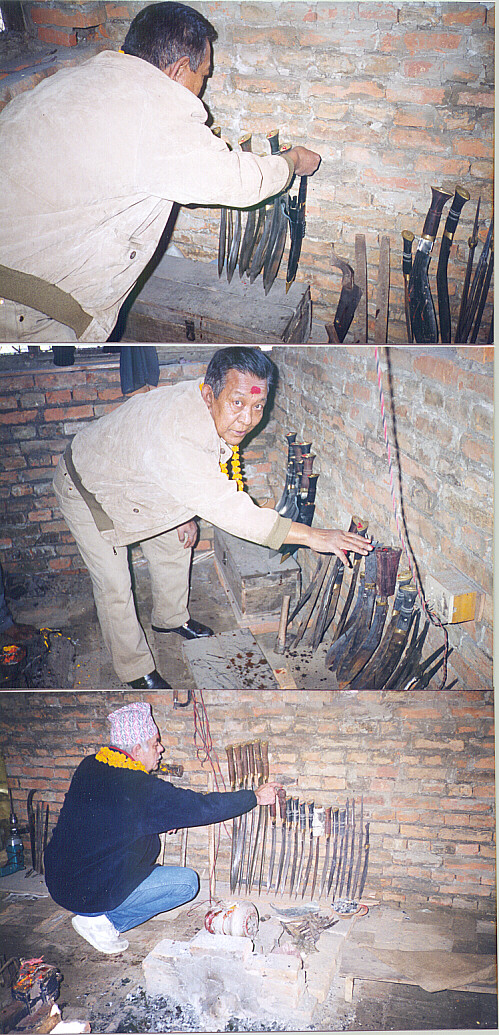
After the kamis have blood blessed all the khukuris both complete and in progress Pala offers an old Gorkha blessing. Uncle Bill offers his own brand of American-Nepali Buddhist blessing. The kamis believe that blood blessing is the only thing that works but tolerate the somewhat unorthodox blessings put up by me. They are very tolerant of their Buddhist brothers and extend special consideration to me for obvious reasons.
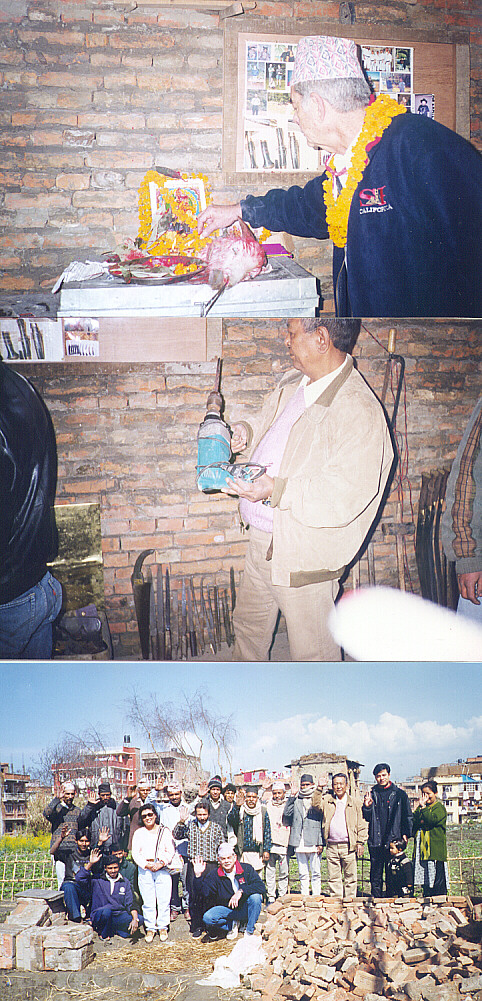
top -- Uncle Bill does his final puja.
center -- Pala makes sure the drill has been properly blessed.
bottom -- The typical "Hello America" pose from some of the Bishwakarma
puja participants.

Bishwakarma puja is finally complete. It has taken the better part of
the morning to get it done. Now the event turns from a religious one to
social. The goat will be cleaned, butchered and cooked as seen in these
pix.
Now the men will visit, drink beer, chang, and Nepali wine, and wait
for the meal to be cooked and served. It is a lively time.
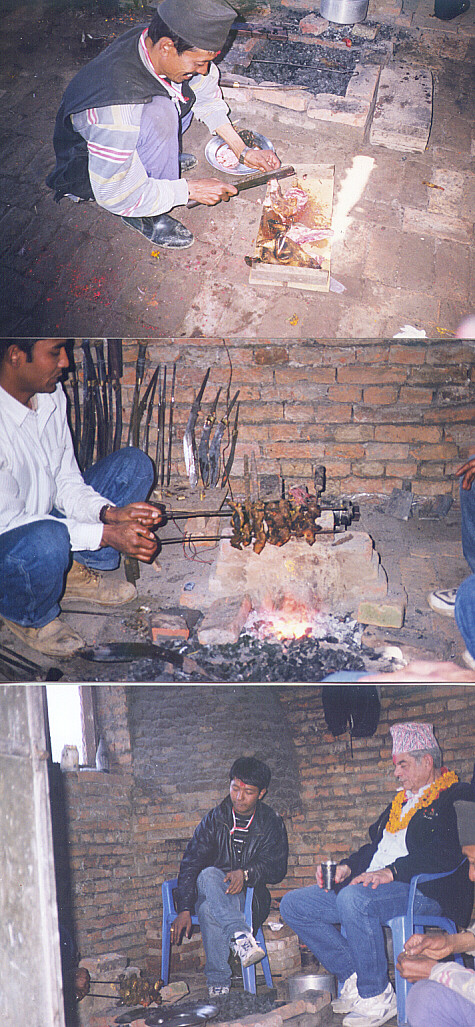
Kesar and Kumar char broil premium cuts of goat meat over Bura's forge. Uncle Bill and Gelbu offer technical advice and wait for the first taste.
Our goat weighed in at 18 KG on the hoof. We were able to feed about 30 people with it and had some to spare. Actually, this goat was a little larger than those generally used for sacrificial purposes. He ended up tasting great. The kamis are very good cooks in addition to being good knife makers.
That's a special knife Kesar made for cutting up chickens, goats, pigs,
whatever. It has more control than a khukuri.
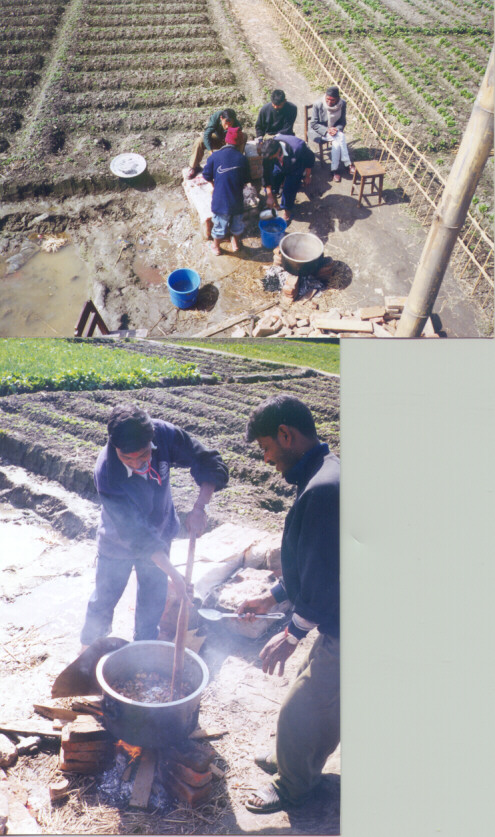
top -- the goat meat is cut into bite sized chucks for the tarkari.
bottom -- Sanu and Prakash cook the tarkari.

Goat meat tarkari, vegetables and rice is finally ready. Mama takes
it upon himself to prepare plates and hand out the food. Inside, outside,
atop the shop, men of BirGorkha partake. Some go back for seconds, thirds
and even fourths -- there is plenty for all and some left over. It is a
good day.
Greetings
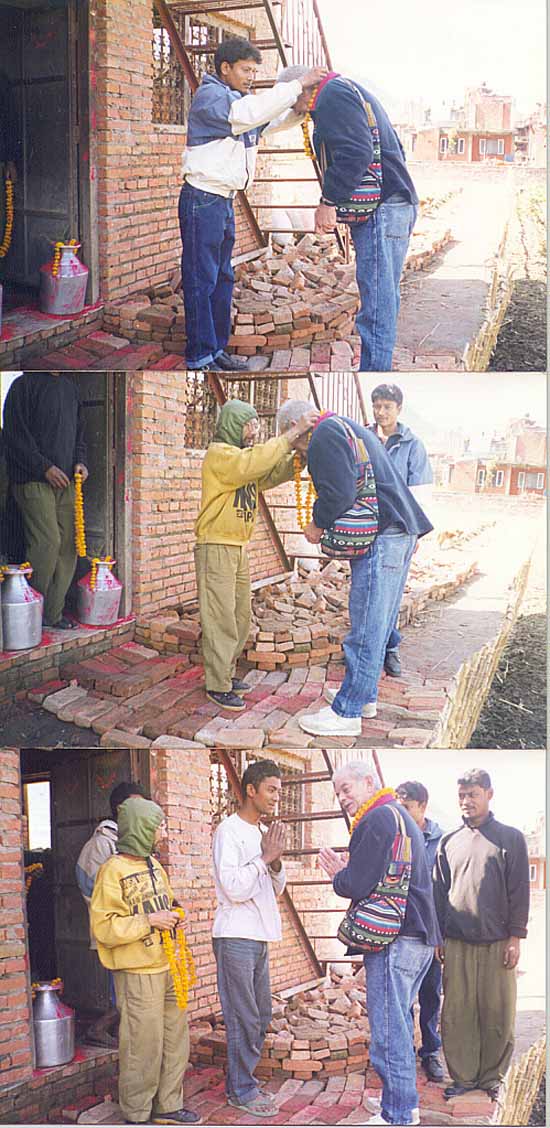
My first visit to BirGorkha was unannounced and for this Gelbu got a great deal of reprimands from the kamis. Although I am not owner of BirGorkha and am not the boss the kamis recognize what I do -- sell their khukuris and send money to Nepal so they can be paid -- as being a very important duty. "Without Bena there would be no BirGorkha and we might be starving. He deserves a proper greeting and certainly deserves our blessings." So here is the way it went.
Here is the first of a series of pictures showing the "official" greeting and blessing by the kamis. This took place the second day on my second visit to the shop.
top -- Gelbu is the photographer. Pradeep, assistant shop manager and next in line to be manager, gives his greeting first.
middle -- Bura, shop foreman, is second to give greetings. Prakash waits in the doorway, third in line.
bottom -- Kumar places a "phool mala" (a lei) around my neck and offers a long flowery welcome. Bura tells him to quit talking and let the next man in line come forward. I chuckle at Bura's comment.
Notice the Tibetan jola I carry. When in Nepal I always carry a jola (cigarettes, bottle of boiled and filtered water, a SAK, couple of candy bars, kleenex, and assorted items necessary when in country) and I generally wear a topi but not on this day. I bought this jola up at the Buddhist temple of Swayambunath, my first day in Nepal. I always do my puja before I do anything else. The jola was made by Tibetans who fled Tibet after the Communist takeover and is very nicely done. It will zip up from the backpack configuration you see to a purse configuration.
Also notice the "gagri" (water buckets) at the doorway. They are filled
with water and decorated with plants and "abir" (the red dye mixed with
grains of rice). The Abir is also sprinkled at the entrance -- "welcome
inside!" This sort of decoration is used for greetings, blessings, weddings
but never funerals.
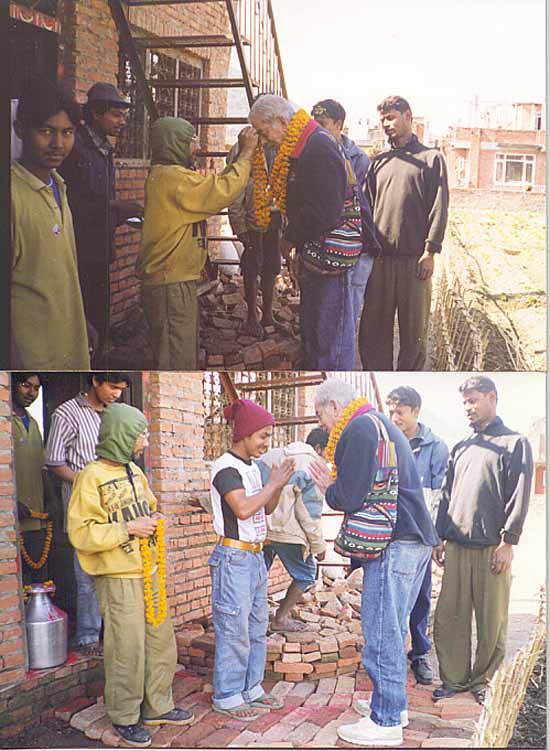
top -- Bura jumps the gun. "I am shop foreman," he says, "so I will
be the first to offer my blessings to Bena."
bottom -- Apprentice Batis offers his greetings. Bura looks on critically
and impatiently.
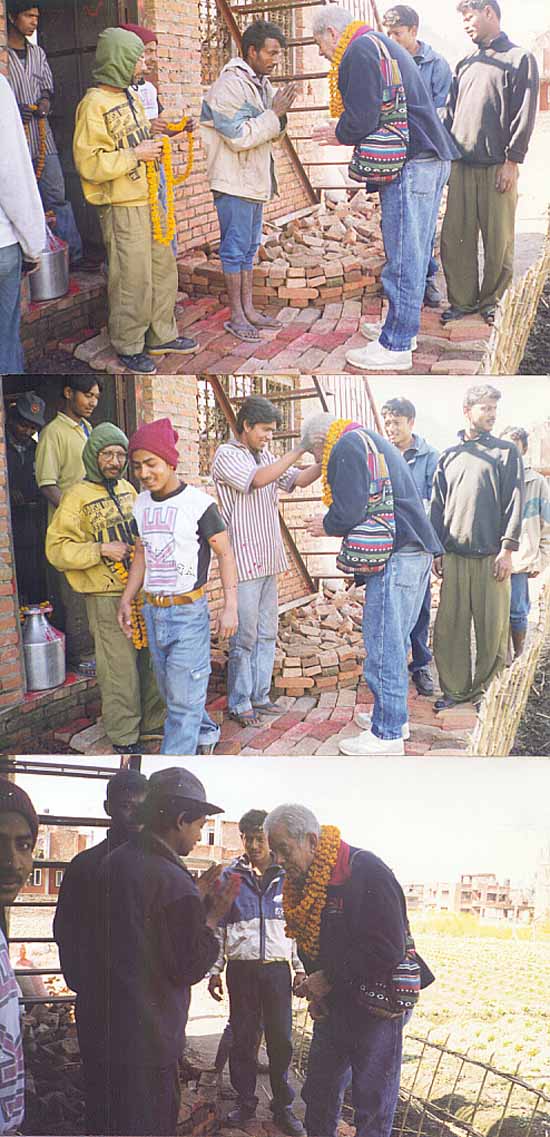
top -- Gosai offers his greeting.
center -- Apprentice Suraj offers greetings. Bura says, "move along, move along," which causes the boys to chuckle.
bottom -- Sanu, a very serious young man, offers a very serious welcome
and greeting.
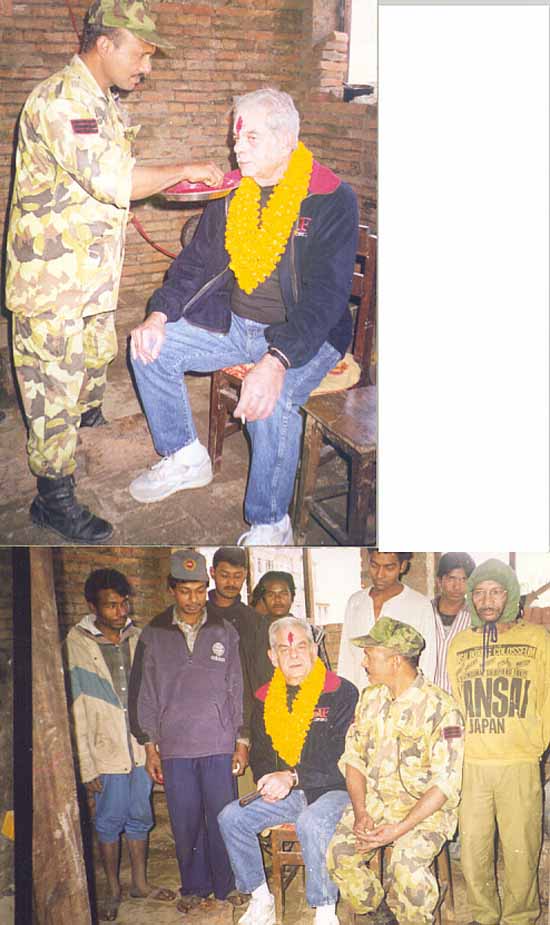
top -- The greeting is a social function. The blessing is a dead serious
religious act. Each of the kamis apply a tika to my forehead and offer
blessings. Sgt. Karka applies the tika and says, "may your life be long,
happy, healthy and prosperous. I pray that God hears my blessings and honors
them. Bless you, Bena."
bottom -- I thank the kamis for the greetings, blessings, and fine
welcome. They listen intently, probably having difficulty understanding
my broken and fractured Nepali. BM 3/2000
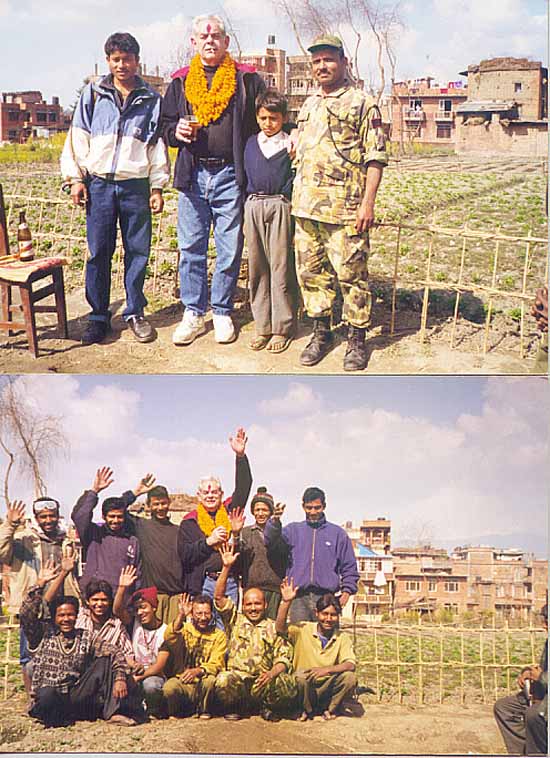
top -- everything's done. Refreshment time. Pradeep, Uncle Bill, Sgt.
Karka's youngest son, Sgt. Karka
bottom -- After a couple of beers, chang, Nepali home brew, a happy
welcoming committee says, "Hello and Namaste America!"

A Nepalese Ferris Wheel constructed with khukuris.
Yesterday we went to Manakamana to visit one of the most popular Hindu shrines in Nepal. The only problem here is foreigners are not allowed entry to the shine. So, I dressed like a somewhat well to do Brahmin might dress, put on my Nepali topi (village style, not tourist) and also donned my Nepali air and decided to speak only Nepali when required.
First test was a small roadside restaurant where our party stopped to eat. I spoke to the Sauni and she buzzed right back in Nepali and soon lost me. But I passed the test. Many old Brahmins are gray haired like me and those who don't hear well might not respond appropriately.
Nest test was the cable car ticket purchasing and ride up the mountain. Nepalis 250 NC about $3.50 round trips -- foreigners $10. I passed this test, too. Not a single question.
Final test was entry to the Manakamana shrine. All leather articles off and stored at a nearby pasal, appropriate puja articles purchased and in hand. I followed Pala and sister-in-law Sanu in the puja, watching closely so that I'd know exactly what to do. When the priest asked my name I had a fictitious one ready, Govinda Neurapane, but just couldn't bring myself to use it. "James," I said. The priest looked up at my brother in law, Nabin, and asked, "Is this man Nepali?" Nabin who is very quick on his feet repled, "His mother is Nepali, father American."
I got the blessing!
All our group called me "Jethadai" which is what the Brahmins call the older men -- big brother essentially. This along with my understanding of Nepali culture, how to move the hand, shaking the head American style no when you really mean yes, and other small items did the trick. Playing a little deaf when I didn't understand probably saved me.
I did think of Sir Richard Burton but I am a very poor imitation.
In my soul I said to Manakamana, "if I am not worthy of this blessing
do not give it. If I am worthy my sincere gratitude." Later, standing outside
the shrine, watching the Magar man put up the prayer flags which had my
name and Yangdu's on them, I knew I had received the blessing.
If you have an HI khukuri or if there is one in your future you should know that the knife has been blessed with Gorkha blood and prayer. Here's how this works.
When we get 20 (that's our standard shipping lot -- 20 give or take a couple) khukuris ready to ship down at the shop my Gorkha brother, Til, leads the blessing ceremony. Til and the kamis nick a finger or thumb and sprinkle a couple of drops of their blood onto the box of khukuris. And, they say a prayer which goes something like this:
A PART OF US HAS GONE INTO EACH KHUKURI, THUS GIVING THE KNIFE THE SPIRIT OF US AND OUR CULTURE AND TRADITION. WE PRAY THAT THE KNIFE IS USED ONLY FOR GOOD AND IS NEVER DRAWN IN ANGER. WE PRAY THAT THE KNIFE SERVES THE OWNER WELL AND WITH THE HONOR AND TRADITION WE SEND WITH THE KNIFE.
As far as I know the HI khukuri is the only knife in the world, including other khukuris, to carry with it such a blessing.
BILL MARTINO 3/3/99
Copyright (c) 1999-2001 by Howard Wallace, all rights
reserved.
This FAQ may not be included in commercial collections
or compilations, or distributed for financial gain, without express written
permission from the author. This FAQ may be printed and distributed
for personal non-commercial, non-profit usage, or as class material, as
long as there is no charge, except to cover materials, and as long as this
copyright notice is included.